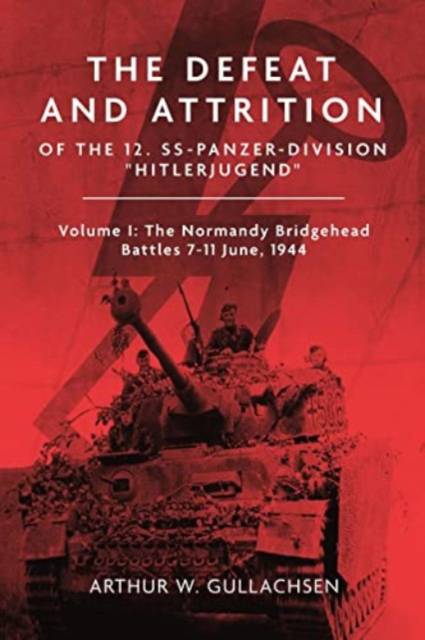
- Afhalen na 1 uur in een winkel met voorraad
- Gratis thuislevering in België vanaf € 30
- Ruim aanbod met 7 miljoen producten
- Afhalen na 1 uur in een winkel met voorraad
- Gratis thuislevering in België vanaf € 30
- Ruim aanbod met 7 miljoen producten
Zoeken
The Defeat and Attrition of the 12. Ss-Panzer-Division "Hitlerjugend"
Volume I: The Normandy Bridgehead Battles 7-11 June 1944
Arthur W Gullachsen
Hardcover | Engels
€ 48,95
+ 97 punten
Omschrijving
"Following his two-volume work, Bloody Verrieres, Arthur W Gullachsen has again written a fantastic book, this time covering the opening days of the Normandy battles involving the Allied Forces and the Hitlerjugend Division. His attention to detail regarding the units fighting between the 6.6.44 to the 11.6.44 is immense." -- Russell A. Hart, Ph.D., Professor of History, Hawai'i Pacific University and author of Clash of Arms How the Allies Won in Normandy
Following the Normandy invasion of 6 June, 1944, Heersgruppe B under German Generalfeldmarschall Erwin Rommel rushed reserves to the newly created bridgehead in order to crush it and drive the Allied forces into the sea. One of these armored reserves was the newly created 12. SS-Panzer-Division Hitlerjugend. Extremely well equipped and at near full strength by mid-1944 standards, it was seen as an extremely capable formation that could defeat any Allied invasion.
During this period studied in this volume, 7-11 June 1944, the 12. SS-Panzer-Division attempted to capture and hold the battlefield initiative, and in conjunction with other Panzer-Divisionen, throw what would become the Second British Army into the sea. The main thesis presented will be that despite this division's best efforts, it was defeated by a firm Allied defence that repulsed their offensive operations, eventually robbing the Germans of the initiative in a grinding series of bridgehead battles.
This first volume will study combat in the period 7-11 June 1944 in the eastern sector of the Normandy Bridgehead. Chapters will analyze the Anglo-Canadian D-Day assault and the deployment of the division, then analyze in detail the fighting of the Hitlerjugend in the following areas: northern Caen, Putot, Bretteville l'Orgueilleuse, Norrey-en-Bessin, Hill 103, Le-Mesnil-Patry, and finally Rots. Also studied will be contrasting German and Anglo-Canadian tactical doctrine, the influence of tactical airpower, and the war crimes committed by the Hitlerjugend immediately after the invasion.
The conclusion will reinforce the thesis presented above and a detailed set of appendices will analyze German personnel, equipment, and armored losses during the battles, and losses inflicted on the Allies. This will be Volume 1 of a planned multi-volume commitment.
Following the Normandy invasion of 6 June, 1944, Heersgruppe B under German Generalfeldmarschall Erwin Rommel rushed reserves to the newly created bridgehead in order to crush it and drive the Allied forces into the sea. One of these armored reserves was the newly created 12. SS-Panzer-Division Hitlerjugend. Extremely well equipped and at near full strength by mid-1944 standards, it was seen as an extremely capable formation that could defeat any Allied invasion.
During this period studied in this volume, 7-11 June 1944, the 12. SS-Panzer-Division attempted to capture and hold the battlefield initiative, and in conjunction with other Panzer-Divisionen, throw what would become the Second British Army into the sea. The main thesis presented will be that despite this division's best efforts, it was defeated by a firm Allied defence that repulsed their offensive operations, eventually robbing the Germans of the initiative in a grinding series of bridgehead battles.
This first volume will study combat in the period 7-11 June 1944 in the eastern sector of the Normandy Bridgehead. Chapters will analyze the Anglo-Canadian D-Day assault and the deployment of the division, then analyze in detail the fighting of the Hitlerjugend in the following areas: northern Caen, Putot, Bretteville l'Orgueilleuse, Norrey-en-Bessin, Hill 103, Le-Mesnil-Patry, and finally Rots. Also studied will be contrasting German and Anglo-Canadian tactical doctrine, the influence of tactical airpower, and the war crimes committed by the Hitlerjugend immediately after the invasion.
The conclusion will reinforce the thesis presented above and a detailed set of appendices will analyze German personnel, equipment, and armored losses during the battles, and losses inflicted on the Allies. This will be Volume 1 of a planned multi-volume commitment.
Specificaties
Betrokkenen
- Auteur(s):
- Uitgeverij:
Inhoud
- Aantal bladzijden:
- 288
- Taal:
- Engels
Eigenschappen
- Productcode (EAN):
- 9781636243474
- Verschijningsdatum:
- 12/09/2024
- Uitvoering:
- Hardcover
- Formaat:
- Genaaid
- Afmetingen:
- 150 mm x 231 mm
- Gewicht:
- 576 g

Alleen bij Standaard Boekhandel
+ 97 punten op je klantenkaart van Standaard Boekhandel
Beoordelingen
We publiceren alleen reviews die voldoen aan de voorwaarden voor reviews. Bekijk onze voorwaarden voor reviews.











